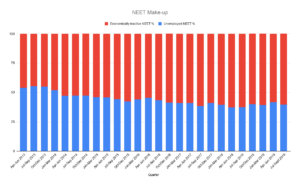ONS NEET key statistics for July to September 2019
- There were 800,000 young people (aged 16 to 24 years) in the UK who were not in education, employment or training (NEET); this number increased by 8,000 from the previous quarter and by 43,000 from the previous year
- The percentage of all young people in the UK who were NEET (NEET rate) was 11.6%; the proportion having risen by 0.1 percentage points from the previous quarter and by 0.7 percentage points from the previous year.
- The proportion of young NEETs who were unemployed dropped from 41.6% to 39.6% (330,000 to 317,000), while the proportion of young NEETs who were economically inactive rose from 58.4% to 60.4% (462,000 to 484,000)
Despite the total population of the 16-24 population continuing to decrease, the NEET rate continues to climb and has been slowly climbing since the July to September quarter of 2018. See below a closer look at the age breakdown showing how each age group has changed with regards to unemployment and economic inactivity.
16-17 NEETs
- The total number of 16-17 year old NEETs rose from 55,000 to 68,000 this past quarter; the highest figure since October to December 2012
- The number of 16-17 year old NEETs who were unemployed has risen from 19,000 to 27,000 (from 35% to 40% of this population group)
- The number of 16-17 year old NEETs who were economically inactive rose from 36,000 to 41,000, but as a proportion of this population group it now only represents 60.1% where it was 65.5% in the previous quarter
18-24 NEETs
- The total number of 18-24 year old NEETs dropped by 4,000 to 733,000 since the previous quarter; but has risen by 24,000 since the previous year
- The number of 18-24 year old NEETs who were unemployed has dropped from 311,000 to 290,000 since the previous quarter (from 42.2% to 39.6% of this population group)
- The number of 18-24 year old NEETs who were economically inactive rose from 426,000 to 443,000 (from 57.8% to 60.4% of this population group)
Commentary
It would appear that 16-17 year old NEETs are experiencing growing unemployment and economic inactivity levels, whereas 18-24 year old NEETs are experiencing a decreasing level of unemployment and an increasing level of economic inactivity. It seems that, quarter after quarter, the past 6 years has seen a rising proportion of the NEET population being made up of the economically inactive (see graph below). In our analysis of the latest unemployment figures released earlier this month, we also cautioned against celebrating the reduced overall unemployment rate as it appeared to be driven by an increase in people of working age leaving the workforce and becoming economically inactive.
There has been some interesting research that looks into economic inactivity. In October this year, the Institute for Employment Studies (IES) released the “Young People’s Future Health Inquiry: The quality of work on offer to young people and how it supports the building blocks for a healthy life”, read our commentary here. Their research discovered a large untapped potential of ‘missing workers,’ especially in cities with weaker economies. For example, they estimated that 52,000 (12% of the working age population) people in Liverpool could be in work if given adequate support. For the UK overall, they estimated that 3.1 million could potentially enter the workforce but are not supported by the system.
In past commentaries we have also discussed the impact of lacking good qualifications on NEET outcome. See our commentary on the latest Impetus research, which found that over half of long-term NEET young people do not have good GCSEs (fewer than five GCSEs at A*-C, and lacking at least one of English and maths).
At Youth Employment UK, we also recognise that a strict focus on quantitative data distracts us from addressing other concerns raised by young people such as stagnant pay growth since the crash of 2009 and lack of quality jobs that offer career progression and development. Other indices and matrices should possibly be considered when discussing the situation for young people and employment. We will continue to keep a close eye on the trends as they develop.
Our work
Since 2012, Youth Employment UK has been committed to tackling these issues on several fronts by:
- Providing expert guidance and support to all organisations working with and employing young people through our Youth Friendly Employer Mark
- Providing online skills training and resources for young people to access with impartial careers information, signposting, case studies and forum
- Providing volunteering opportunities for young people who wish to gain work experience whilst fighting youth unemployment
- Influencing and supporting the political agenda to ensure that youth employment remains a government priority, and that the views of young people and our Youth Friendly Employer Community are being heard
- Work closely with partners in the sector to cohesively offer best-practice solutions to ensure more young people successfully achieve their potential








